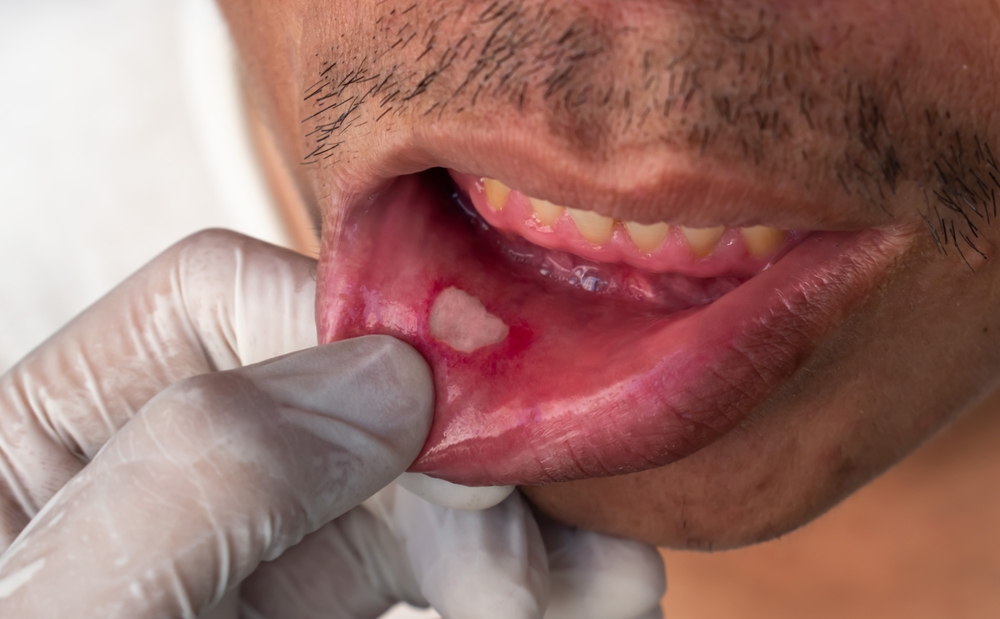That painful sore that appeared inside your cheek makes eating spicy foods pure torture and talking uncomfortable. While you might dismiss it as just another annoying canker sore that will heal on its own, these small but mighty ulcers sometimes tell a bigger story about what’s happening inside your body. Your mouth might actually be sending you important nutritional warning signals you shouldn’t ignore.
Beyond the ordinary canker sore mystery
Mouth ulcers, those small, round or oval sores with a white or yellow center and a red border, affect nearly everyone at some point. While occasional ulcers often result from minor injuries like accidentally biting your cheek or trauma from dental work, recurring or multiple ulcers might indicate your body is missing crucial nutrients.
What makes these vitamin connections particularly interesting is how specific they can be. Different vitamin deficiencies create distinctive patterns of ulcers, appearing in characteristic locations or with unique features that provide clues about exactly which nutrients your body lacks.
These patterns aren’t coincidental. Your mouth tissues regenerate incredibly quickly, with the entire lining replacing itself roughly every 7-14 days. This rapid cell turnover makes oral tissues especially vulnerable to nutrient shortfalls, creating visible changes before other body systems show symptoms.
The B vitamin connection you can’t afford to miss
B vitamins play starring roles in mouth health, with several members of this vitamin family linked directly to oral ulcers when levels run low. B12 deficiency frequently announces itself through particularly persistent mouth sores that resist healing, often appearing alongside a distinctive red, smooth tongue.
This B12-ulcer connection makes biological sense. Vitamin B12 enables proper DNA synthesis and red blood cell formation, both essential for tissue repair and regeneration. Without adequate B12, the rapidly dividing cells in your mouth lining can’t replace themselves properly, leading to breakdown and ulceration.
People following plant-based diets face particular risk for this deficiency since B12 occurs naturally only in animal products. However, even meat-eaters sometimes develop deficiencies due to absorption issues, especially those with digestive conditions or those taking certain medications like metformin or proton pump inhibitors.
Other B vitamins create their own ulcer patterns. Folate deficiency often causes ulcers at the gum line and inner lip, while riboflavin shortfalls tend to create cracks at the corners of the mouth alongside ulcers on the tongue. Recognizing these distinctive presentations helps pinpoint exactly which nutrient requires attention.
The iron factor that doctors frequently overlook
Iron deficiency affects over two billion people worldwide, making it the most common nutritional deficiency globally. Before full-blown anemia develops, suboptimal iron levels often manifest in the mouth through recurring ulcers that typically appear on the inside of the lips and cheeks.
What makes iron-related ulcers distinctive is their tendency to recur in the exact same spot, almost like the tissue there never fully heals before breaking down again. This pattern reflects iron’s critical role in tissue integrity and wound healing throughout the body.
Women experience this connection more frequently due to menstrual blood loss, with studies showing premenopausal women have nearly twice the rate of recurrent mouth ulcers compared to men of the same age. The timing often follows a monthly pattern too, with ulcers appearing predictably a few days after menstruation when iron levels typically reach their lowest point.
Vegetarians and vegans face additional risk since plant sources contain non-heme iron, which the body absorbs less efficiently than the heme iron found in animal products. This absorption difference explains why plant-based eaters sometimes develop iron-related mouth ulcers despite consuming seemingly adequate amounts on paper.
The zinc puzzle piece most people miss
Zinc deficiency creates perhaps the most distinctive oral signature. When levels of this mineral run low, ulcers typically develop on the tongue and inner cheeks, often appearing in crops of multiple sores at once rather than as isolated lesions.
The connection makes sense biologically, as zinc participates in over 300 enzymatic reactions in the body, many directly involved in tissue growth, wound healing, and immune function. Without adequate zinc, your mouth tissues become both more vulnerable to breakdown and less capable of repair when damage occurs.
Certain populations face higher risk for this deficiency, including older adults, pregnant women, people with digestive disorders, and those taking medications that deplete zinc. Heavy exercisers sometimes develop deficiencies too, as significant amounts of zinc exit the body through sweat.
Dietary choices influence zinc status significantly. While oysters, beef, and pumpkin seeds offer rich sources, phytates in whole grains, legumes, and nuts can bind zinc and reduce its absorption. This interaction explains why some people consuming seemingly adequate zinc still develop deficiency symptoms, including characteristic mouth ulcers.
The vitamin C story beyond just scurvy
Most people associate severe vitamin C deficiency with scurvy, a historical disease of sailors that caused teeth to fall out. But long before reaching scurvy levels, milder vitamin C insufficiency often manifests through mouth ulcers with distinctive bleeding edges, particularly along the gumline.
What makes this connection fascinating is how quickly it responds to correction. While many nutrient-related ulcers heal slowly over weeks, vitamin C-related sores often show improvement within days of increasing intake, reflecting this vitamin’s immediate role in collagen production and tissue integrity.
Modern diets create surprisingly common vitamin C shortfalls despite abundant food supply. Stress depletes vitamin C rapidly, as does smoking, both increasing requirements above typical recommendations. Heat and light destroy this fragile vitamin during cooking and storage, meaning even people consuming “enough” fruits and vegetables sometimes develop functional deficiencies.
The distinctive bleeding tendency of vitamin C-related ulcers helps distinguish them from other types. Light pressure causes easy bleeding around these ulcers, reflecting vitamin C’s critical role in maintaining blood vessel integrity throughout the body, including in the delicate oral tissues.
The surprising vitamin A connection
Vitamin A deficiency creates a unique pattern of oral changes, including ulcers accompanied by distinct dryness and thickening of the mouth lining. These changes reflect vitamin A’s essential role in maintaining mucous membranes throughout the body.
What’s particularly notable about vitamin A-related mouth changes is how they often appear alongside other symptoms like night blindness or dry eyes, creating a constellation of related issues that all stem from the same nutritional shortfall.
While outright vitamin A deficiency seems rare in developed countries, subclinical insufficiency appears more common than previously recognized, particularly among those with fat malabsorption conditions, heavy alcohol users, and strict dieters limiting fat intake.
Plant sources provide beta-carotene, which converts to vitamin A in the body, but this conversion proves dramatically less efficient than once thought. Some people convert as little as 4% of dietary beta-carotene to active vitamin A, explaining why even those consuming plenty of carrots and sweet potatoes sometimes develop manifestations of insufficiency.
The oral-systemic connection you need to understand
The mouth-body connection works both ways, with oral ulcers sometimes reflecting systemic issues beyond simple nutrient deficiencies. Celiac disease, inflammatory bowel conditions, and autoimmune disorders frequently manifest in the mouth before producing obvious digestive symptoms.
What makes this connection particularly valuable is its potential for early detection. Mouth ulcers might appear months or even years before classic symptoms of these conditions, providing an opportunity for earlier diagnosis and treatment when outcomes generally prove more favorable.
The timing often provides important clues. While nutrient-related ulcers typically develop gradually with increasing frequency as deficiency progresses, those stemming from systemic conditions often appear suddenly in crops, sometimes alongside other oral changes like gum inflammation or tongue abnormalities.
For those experiencing persistent or recurrent mouth ulcers, comprehensive evaluation sometimes reveals unexpected systemic issues alongside nutritional factors. This overlap explains why addressing vitamin status alone sometimes produces incomplete improvement until underlying conditions receive proper treatment.
Beyond just popping supplements
Addressing nutrient-related mouth ulcers requires thoughtful approach beyond simply taking supplements. While supplementation often proves necessary, particularly for nutrients like B12 and iron when deficiencies are significant, sustainable improvement typically requires addressing root causes.
Digestive health plays a central role, as even perfect dietary intake provides little benefit if absorption falters. Common issues like low stomach acid, intestinal inflammation, and imbalanced gut bacteria all compromise nutrient absorption regardless of intake quality or quantity.
Food combining strategies improve absorption of vulnerable nutrients. Consuming vitamin C alongside plant-based iron sources increases iron absorption up to sixfold, while eating zinc-rich foods separate from high-phytate meals maximizes zinc availability. These strategic approaches often prove more effective than supplements alone.
Lifestyle factors dramatically impact nutrient status beyond intake. Chronic stress depletes B vitamins and vitamin C rapidly, while insufficient sleep compromises gut function and nutrient absorption. Addressing these foundational factors often resolves recurring mouth ulcers more completely than nutritional interventions alone.
Those persistent mouth ulcers deserve more attention than most people give them. Beyond being painful nuisances, they often provide valuable clues about nutritional gaps that affect your entire body, not just your mouth. By recognizing these connections and addressing the underlying causes, you potentially resolve not just the oral symptoms but also unseen issues affecting your broader health and wellbeing.
















